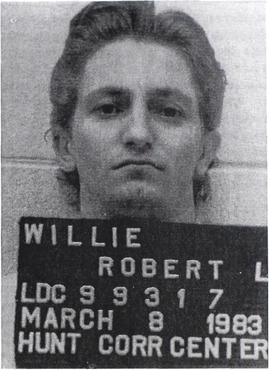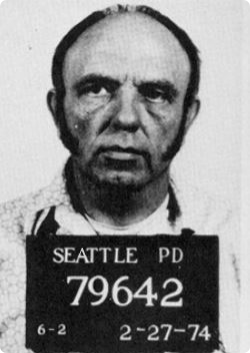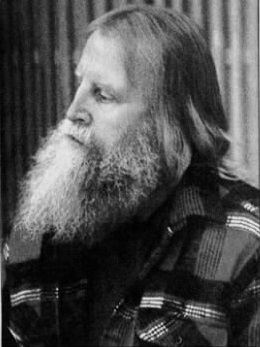Yolanda Saldívar is an American former nurse who was convicted of the murder of American singer Selena in 1995. Saldívar had been the president of Selena's fan club and the manager of her boutiques, but she lost both positions a short time before the murder, when the singer's family discovered that she had been embezzling money from both organizations.
Yahweh ben Yahweh was an American religious leader, black separatist and black supremacist and founder of the Nation of Yahweh, a new religious movement headquartered in Florida that, at its peak, had thousands of black American devotees. He preached that Jesus was black and that "white devils" temporarily rule over black people, and was accused of teaching hate. Yahweh was indicted on three counts of federal racketeering and extortion charges, of which he was found not guilty. However, he was convicted of conspiracy to commit murder.

Following the historic Lindbergh kidnapping, the United States Congress passed a federal kidnapping statute—known as the Federal Kidnapping Act, 18 U.S.C. § 1201(a)(1) —which was intended to let federal authorities step in and pursue kidnappers once they had crossed state lines with their victim. The act was first proposed in December 1931 by Missouri Senator Roscoe Conkling Patterson, who pointed to several recent kidnappings in the Missouri area in calling for a federal solution. Initial resistance to Patterson's proposal was based on concerns over funding and state's rights. Consideration of the law was revived following the kidnapping of Howard Woolverton in late January 1932. Woolverton's kidnapping featured prominently in several newspaper series researched and prepared in the weeks following his abduction, and were quite possibly inspired by it. Two such projects, by Bruce Catton of the Newspaper Enterprise Association and Fred Pasley of the Daily News of New York City, were ready for publication within a day or two of the Lindbergh kidnapping. Both series, which ran in papers across North America, described kidnapping as an existential threat to American life, a singular, growing crime wave in which no one was safe.

Jesse Joseph Tafero was convicted of murder and executed via electric chair in the U.S. state of Florida for the murders of 39-year-old Florida Highway Patrol officer Phillip A. Black and 39-year-old Ontario Provincial Police Corporal Donald Irwin, a visiting Canadian constable and friend of Black. The officers were killed during a traffic stop where Tafero, his wife Sunny Jacobs and their children were passengers. Tafero's execution was botched; his head burst into flames during the execution by electric chair. After Tafero's execution, the driver, Walter Rhodes, confessed to shooting the officers, but later retracted his testimony.

Glennon Edward Engleman was an American dentist, contract killer, and serial killer. Engleman, a United States Army veteran and a St. Louis dentist, planned and carried out at least five murders for monetary gain over the course of 30 years. He was already serving two life sentences in a Missouri state prison when he pled guilty to the murder of a man and his wealthy parents in a separate contract killing that occurred in Illinois. Engleman was a sociopath, once stating that his talent was to kill without remorse, and he enjoyed planning and carrying out killings and disposing of the remains in order that it would net him financial rewards. His first known killing occurred in collaboration with his ex-wife. His ex-wife Ruth married another man, raised his life insurance and then Engleman killed him, both sharing the benefits. Later he would repeat these tactics for other murders.

The Ripper Crew or the Chicago Rippers was an organized crime group of serial killers, cannibals, rapists, and necrophiles. The group composed of Robin Gecht and three associates: Edward Spreitzer, and brothers Andrew and Thomas Kokoraleis. They were suspected in the murders of 17 women in Illinois in 1981 and 1982, as well as the unrelated fatal shooting of a man in a random drive-by shooting. According to one of the detectives who investigated the case, Gecht "made Manson look like a Boy Scout."

Steven Howard Oken was an American spree killer who raped and murdered three women in Maryland and Maine in November 1987. He was sentenced to death and executed in Maryland by lethal injection in 2004.

Robert Lee Willie was an American serial killer who killed at least three people in Louisiana from the late 1970s to 1980. He was sentenced to death for the rape and murder of 18-year-old Faith Hathaway and was executed in 1984.

The United States Penitentiary, Beaumont is a high security United States federal prison for male inmates in unincorporated Jefferson County, Texas. It is part of the Federal Correctional Complex, Beaumont and is operated by the Federal Bureau of Prisons, a division of the United States Department of Justice.
Tyrone Delano Gilliam Jr. was an American convicted murderer executed by the state of Maryland in 1998. Gilliam was convicted and sentenced to death for the kidnapping and murder of 21-year-old Christine J. Doerfler on December 2, 1988.

Jalil Abdul Muntaqim is a political activist and former member of the Black Panther Party (BPP) and the Black Liberation Army (BLA) who served 49 years in prison for two counts of first-degree murder. In August 1971, he was arrested in California along with Albert “Nuh” Washington and Herman Bell and charged with the killing of two NYPD police officers, Waverly Jones and Joseph A. Piagentini, in New York City on May 21. In 1975, he was convicted on two counts of first-degree murder and sentenced to life imprisonment with possible parole after 22 years. Muntaqim had been the subject of attention for being repeatedly denied parole despite having been eligible since 1993. In June 2020, Muntaqim was reportedly sick with COVID-19. He was released from prison on October 7, 2020, after more than 49 years of incarceration and 11 parole denials.

Harvey Louis Carignan was an American serial killer who was sentenced to life in prison for the murders of two women in the early 1970s. He had been previously convicted of a 1949 rape and murder he committed while stationed in the U.S. Army, in Anchorage, Alaska. He was imprisoned at the Minnesota Correctional Facility – Faribault until his death in 2023.

Smith v. Spisak, 558 U.S. 139 (2010), was a United States Supreme Court decision on the applicability of the Antiterrorism and Effective Death Penalty Act of 1996. It further examined issues of previous court decisions on jury instructions and the effectiveness of counsel.
Daniel J. LaPlante is an American convicted murderer serving multiple life sentences for the 1987 murders of Priscilla Gustafson and her two children in Townsend, Massachusetts.
Kaboni Savage is an American drug dealer, organized crime leader, and mass murderer who is currently on federal death row for ordering the firebombing of a house where a federal witness lived, killing six people. He is the first man from Philadelphia in modern history to receive a federal death sentence. He has twelve convictions for murder in aid of racketeering, one fewer than the Pennsylvania state record, and the most for anyone in Philadelphia. Savage was the first person sentenced to death by the United States District Court for the Eastern District of Pennsylvania since the federal death penalty resumed in 1988.

On March 28, 1996, Donovan Corey Parks, an American corrections officer, was murdered by two gang members in Baldwin County, Georgia. His two killers: Robert Earl Butts Jr. and Marion Wilson Jr. were executed for the crime by the state of Georgia via lethal injection, in 2018 and 2019, respectively. Wilson was the 1,500th person to be executed in the United States since capital punishment was resumed in 1976.

Wesley Ira Purkey was an American convicted murderer who was executed by the United States federal government for the January 1998 kidnapping, rape, and murder of 16-year-old Jennifer Long. Purkey confessed to the crime while serving a life sentence for the murder of 80-year-old Mary Ruth Bales, whom he beat to death with a claw hammer in October 1998.
Randy William Gay is an American serial killer who killed three people, including his father-in-law and his biological father, with a shotgun during arguments between 1978 and 2011. He served time in prison for each of the first two murders, and was sentenced to death for the third murder.

Walter Hill was an American serial killer who killed five people between 1952 and 1977. He was convicted of capital murder, sentenced to death, and executed at Holman Correctional Facility in Alabama in 1997.

Robert Ronald "Mudman" Simon, also known as Bobby Simon, was an American outlaw biker, convicted murderer and member of the Pennsylvania-based Warlocks Motorcycle Club. He had formerly been sentenced to death by the state of New Jersey on May 6, 1995, for his part in the fatal shooting of Franklin Township police sergeant Ippolito Gonzalez. However, he was ultimately beaten to death at New Jersey State Prison by a fellow death row inmate before he could be executed.














